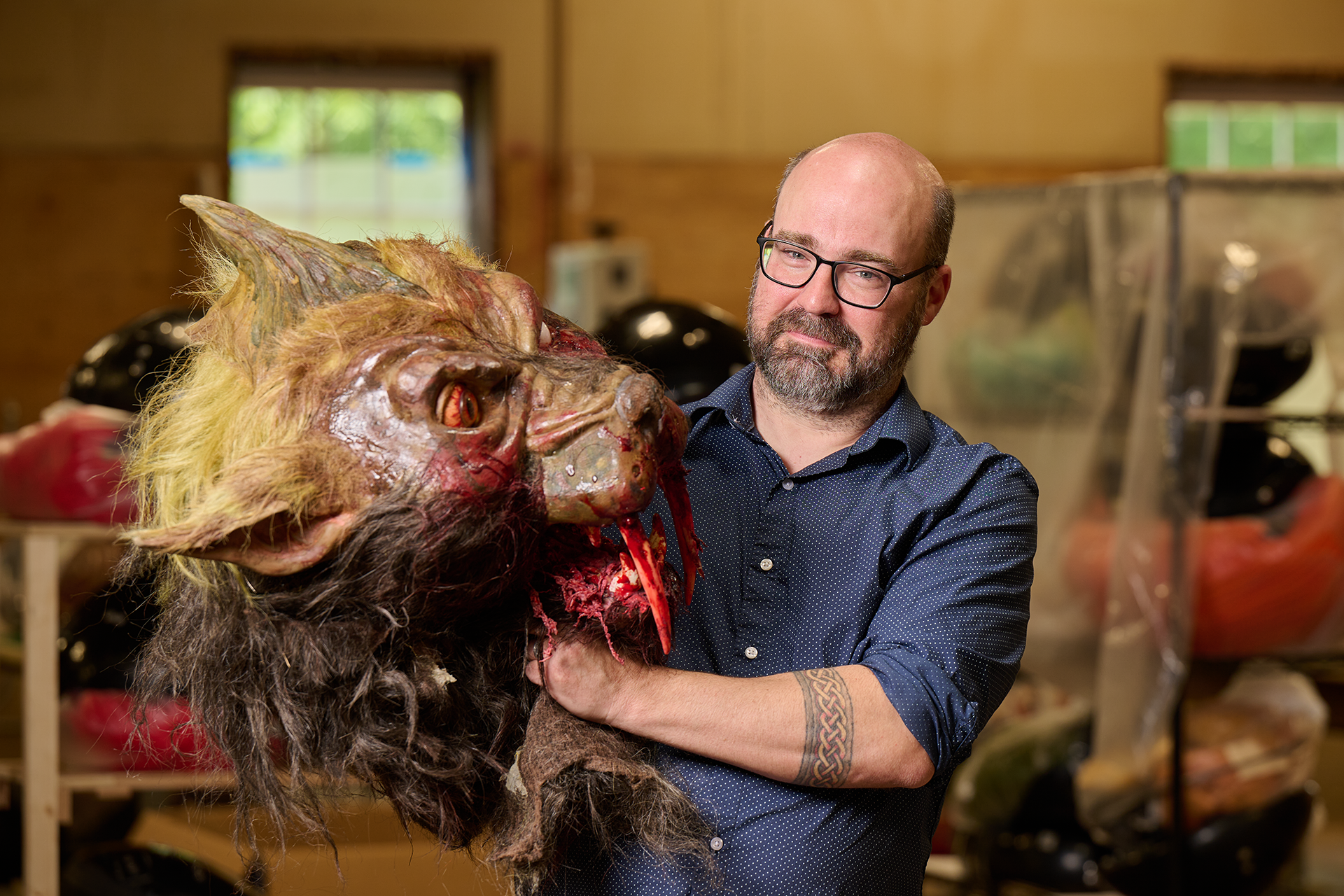
Rob Saunders
Unmasked
How a UConn puppeteer went from being the beer guy at Whole Foods to creating animatronics for the biggest theme parks, robotics for cinematic superheroes, and crazy-clever costumes for Masked Singers.
By Tommi Lewis Tilden
Photos by Peter Morenus
It
It was 1990, and the world was mourning the untimely death of iconic puppet master Jim Henson. A 16-year-old aspiring puppeteer in Chester, New Hampshire, Rob Saunders ’96 (SFA) had long admired Henson’s artistry and aesthetic, the way he blended otherworldly elements and realism on children’s television shows like “The Muppets” and “Sesame Street,” and in fantasy cinematic visions like “Labyrinth” and “The Dark Crystal.”
“For a young person his passing was like a call to arms, to take up the mantle. It sparked a sense of purpose for me and other puppeteers that came out of that time, we felt compelled to carry on his legacy. I felt I gotta do this.”
Sitting in his high school counselor’s office, Saunders discovered that answering the call could mean earning $13,000 a year. “To my teenage mind, that figure sounded amazing. In that moment, it was clear to me where I was heading.”
Saunders set his sights on, and gained admittance to, UConn’s School of Fine Arts, renowned for its illustrious puppetry program, and in so doing became the first of his family to attend college. Almost immediately, he found himself working with the esteemed, longtime head of UConn’s puppetry program, Bart Roccoberton Jr., on a production of “A Christmas Carol.”
Off and running, Saunders immersed himself in courses for performance, directing, design, and fabrication, and created lifelong friendships with fellow puppeteers including David Regan ’95 (SFA), ’01 MFA; Tim Legasse ’92 (SFA); Jennifer Barnhart ’94 (SFA); and Jim Napolitano ’93 (SFA). “They’re all UConn grads who went on to do well commercially,” he says, citing some of their collective work with entertainment giants The Jim Henson Co., The Walt Disney Co., PBS, and Nickelodeon.
Jim Henson Lesson #1: As you start traveling down that road of life, remember this: There are never enough comfort stops. The places you're going to are never on the map.
For five years post-graduation, Saunders honed his craft. “I moved to Nashville fresh out of college to work as a junior fabricator, building puppets. It was a steady gig, and I learned a lot.” Following a brief move to New York City, Saunders ended up with relatives in Toronto where he met special effects designer Gordon Smith. “Gordon couldn’t hire me because I wasn’t Canadian,” Rob explains, “but I ended up working for him for free on a film character with claws.” Those claws turned out to be for Hugh Jackman’s first appearance as Wolverine in “X-Men.”
Broke, but teeming with inspiration, Saunders returned to New York City to work as a mold maker at a stop-motion shop. “I loved New York, but the type of projects I wanted to be involved in were primarily in Los Angeles. New York has a huge television puppeteer network, but I wanted to focus more on monsters and creature effects at that point in my career. So I left to check out Hollywood’s film and entertainment scene.”
Saunders landed in LA two days before the catastrophic events of 9/11 unfolded. The entertainment industry ground to a halt and work was scarce. “I ended up taking a job at Whole Foods as their beer guy, but kept knocking on doors and sending out resumes.” Finally, opportunity struck in the form of a web-slinging superhero bringing much needed traction to Saunders’ career. Steve Johnson’s EdgeFX was seeking an artist to create a prototype for a costume in “Spider-Man 2” and Saunders seized the chance, earning his first break in the 2004 blockbuster hit with the credit “Puppeteer: Doc Ock Tentacle.”
Saunders was a member of the puppeteering team that helped create and manipulate the arms in the film-stealing scenes where Alfred Molina’s villain character Doctor Octopus pleads and interacts with his sentient, clawed tentacles. This visual effect became a revered part of movie lore and is one reason for the film’s critical acclaim.
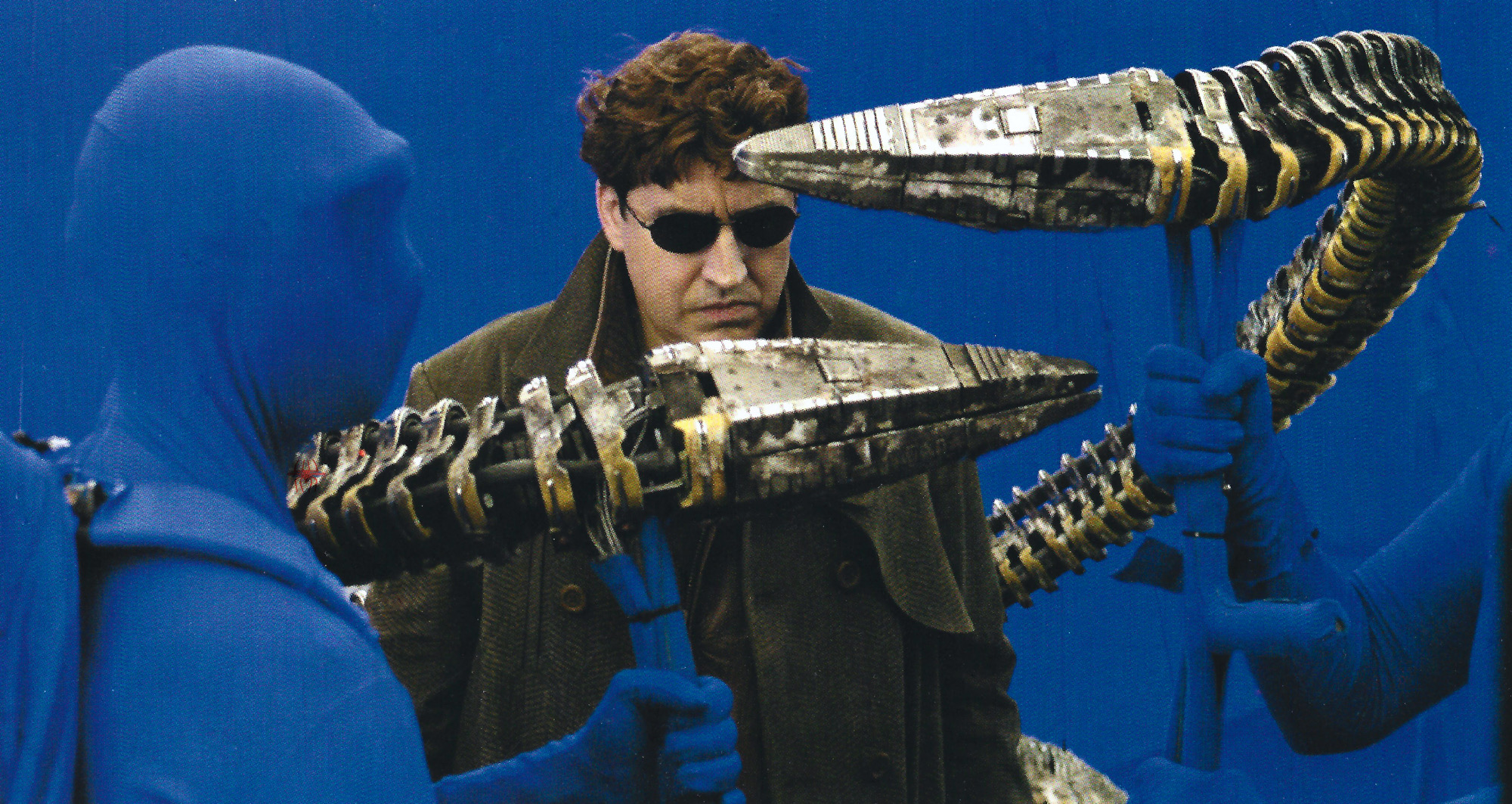
From left: Puppeteers guide Doc Ock’s swinging tentacles in “Spider-Man 2”; creators Trey Parker and Matt Stone provided voices for several “Team America: World Police” characters; Hugh Jackman’s first stab as Wolverine; the singer underneath the leopard mask was revealed to be Seal.
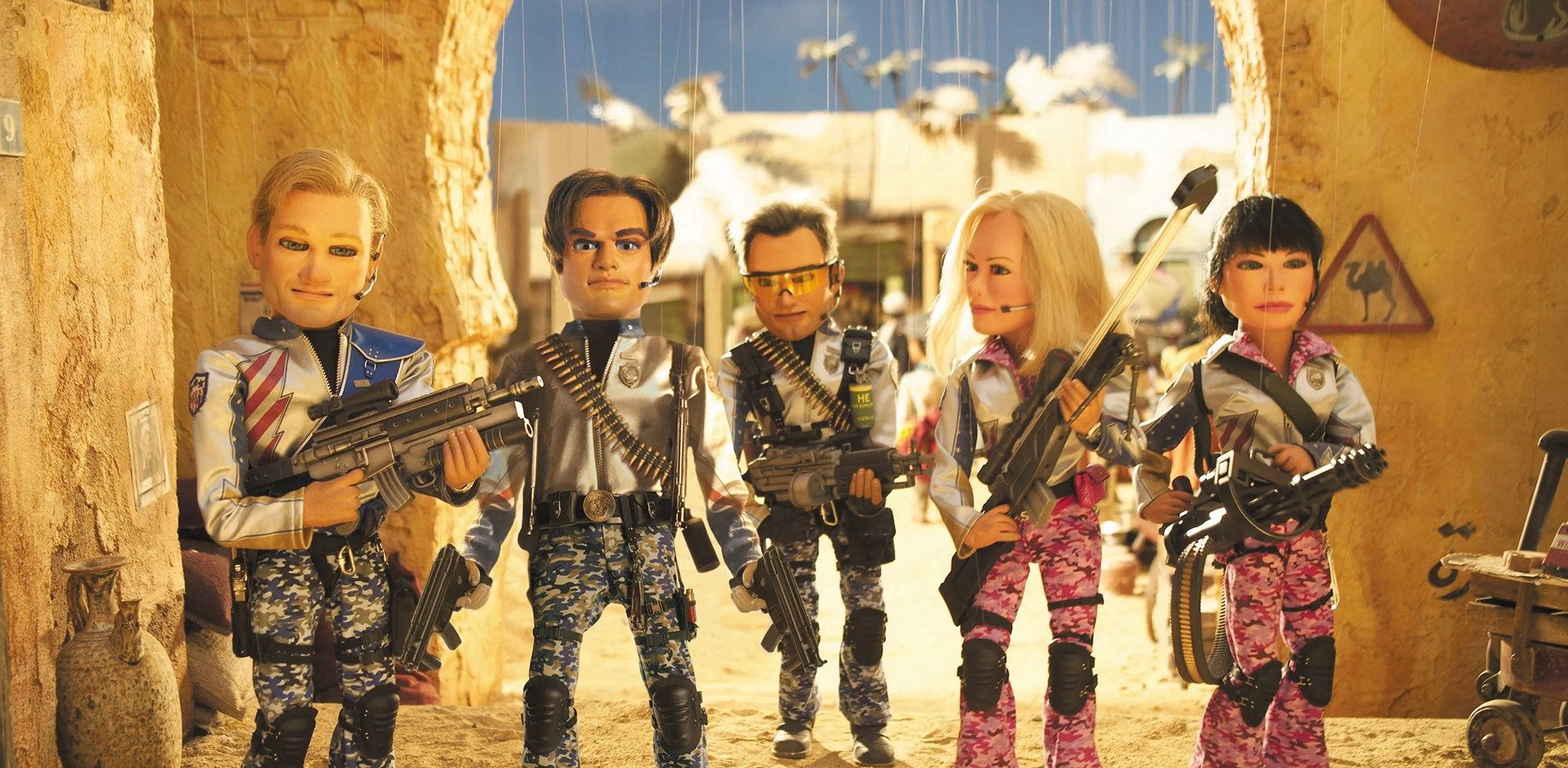

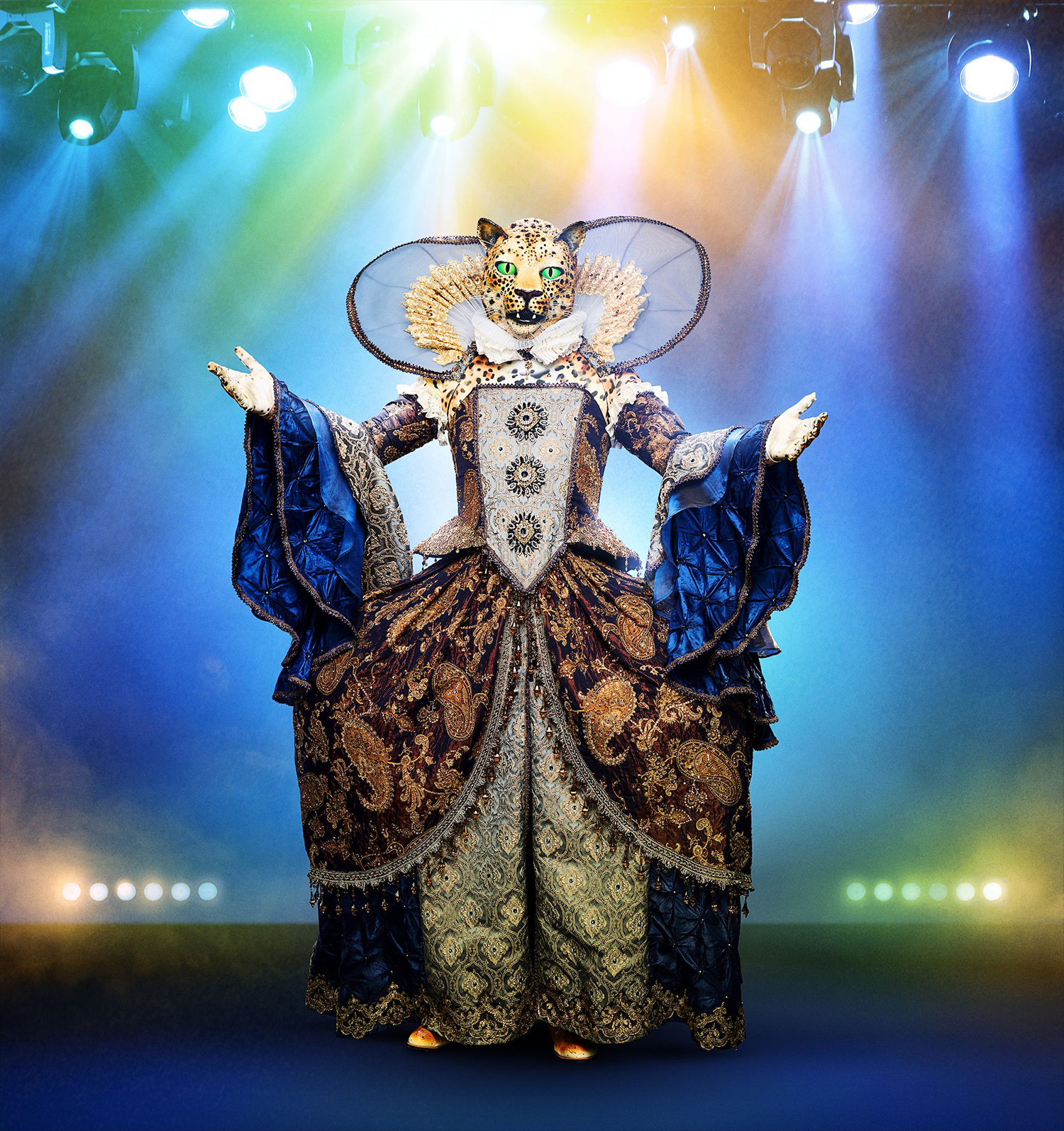
From Top: Puppeteers guide Doc Ock’s swinging tentacles in “Spider-Man 2”; creators Trey Parker and Matt Stone provided voices for several “Team America: World Police” characters; Hugh Jackman’s first stab as Wolverine; the singer underneath the leopard mask was revealed to be Seal.
Word of Saunders’ talent spread throughout the industry. “South Park” creators Trey Parker and Matt Stone tapped him for their edgy and satirical “Team America: World Police,” which relies on puppets, miniature sets, and punchlines based on the ridiculousness of seeing the childlike, near-human characters in precarious situations.
The puppets were about 18 inches, head to toe, says Saunders. “They were very complex and had nine motors inside their heads to make expressions. Some puppets had up to 12 strings for one controller.” Parker and Stone “dumbed down” the puppets to meet their specific vision, though, not using all they were capable of. “I loved working with those guys,” Saunders says with a smile. “They are brilliant writers and filmmakers. But I don’t think they knew how hard it would be working with puppets.”
Besides acting as a puppet wrangler for the tight 60-day production schedule with 20-hour workdays, Saunders was the puppeteer for a bartender in a scene where one of the lead characters, Sarah, shoots up a bar filled with terrorists. “I was wrapped in fire blankets with all these explosives going off over my head and had to keep my character moving stoically around the bar, doing his thing,” he remembers. “And my character survived!”
Transitioning to a less explosive project and deepening his connection to Jim Henson, Saunders served as a legacy effects artist on the 2011 feature film “The Muppets.”
“I built a suit for the movie called the ‘Muppet Man,’ where all the Muppets hide in a human three-piece suit to break into Miss Piggy’s office,” he says of the first and only time he worked with the Muppet characters. “The puppet community is so small, you tend to meet everyone. Years ago, I met Heather, Jim’s youngest child, at a national puppet conference and we became friends. But weirdly, I never really pursued a career with the Henson Company.”
“I was wrapped in fire blankets with all these explosives going off over my head and had to keep my character moving stoically around the bar, doing his thing.”
Jim Henson Lesson #2: It's one of the basic truths of the universe. Things don't disappear. They just change and change and change again.
Fifteen successful years of freelance and impressive credits led Saunders to a full-time position in Nashville as VP of Operations for Animax, which specializes in theme park experiences. “When I joined, we had a team of 26 people. By the time I left in 2018, that number had skyrocketed to 102. The owner wanted to rebrand from a small, whimsical puppet shop to a cutting-edge company designing mechanical animatronics for theme parks. So that’s what we did.”
Saunders says he enjoyed running a company without the responsibility of owning it. “We did incredible work. But something was missing … It was all about machines.”
Machines?
“The process of building high-level animatronics for theme parks is complex,” he explains. “You start with creative design. And then you layer in the mechanical design, the number of movements, how it works, whether it uses electric motors, air pistons, or hydraulics. You also need to take in the power and safety needs, and how long it can last while operating seven days a week in often humid conditions.
“You can't embrace and connect with [animatronics] in the same way as with puppets. My joke has always been that we were making bulldozers with fur.”
“Animatronics are undeniably fascinating, but they can feel like powerful, weighty machines,” he continues. “You can’t embrace and connect with them in the same way as with puppets. My joke has always been that we were making bulldozers with fur.”
Those cold, furry bulldozers made Saunders miss the tactile magic of puppetry and costumes.
When Stoopid Buddy Stoodios in Los Angeles invited him to work on “The Masked Singer,” the timing couldn’t have been better. “It was an intense schedule but exhilarating work,” he says of his five seasons working on the show. “The biggest challenge is making sure the masks are acoustically sound, with no reverb or interference. We have specialty microphones, but often need to adapt and reshape the foam inside the mask so the talents’ voices can be heard.”
While the world collectively grappled with the 2020 pandemic, Saunders worked on the show remotely from Nashville. “I had a small office set up in my house and was working with a builder in Los Angeles. We would get a drawing and come up with a budget and plan how to build it,” he says. “Then I’d go to Los Angeles to work with the team on it.”
Did he know what celebrity he was creating for in advance? “Never,” he insists. “They kept that a secret. All we had were general specs about the person, like shape and size, or if a person was older or frail so we wouldn’t make the costume too heavy.”
Yet show business doesn’t always go as planned.
“We’d only meet the celebrity at the first fitting,” Saunders says. “One time we made this elaborate leopard costume for a petite woman. Turns out she changed her mind last minute and they replaced her with the musician Seal, who is 6’3”. So,we had to rebuild the costume to accommodate him. We were always dealing with last-minute alterations.”
“You can't embrace and connect with [animatronics] in the same way as with puppets. My joke has always been that we were making bulldozers with fur.”
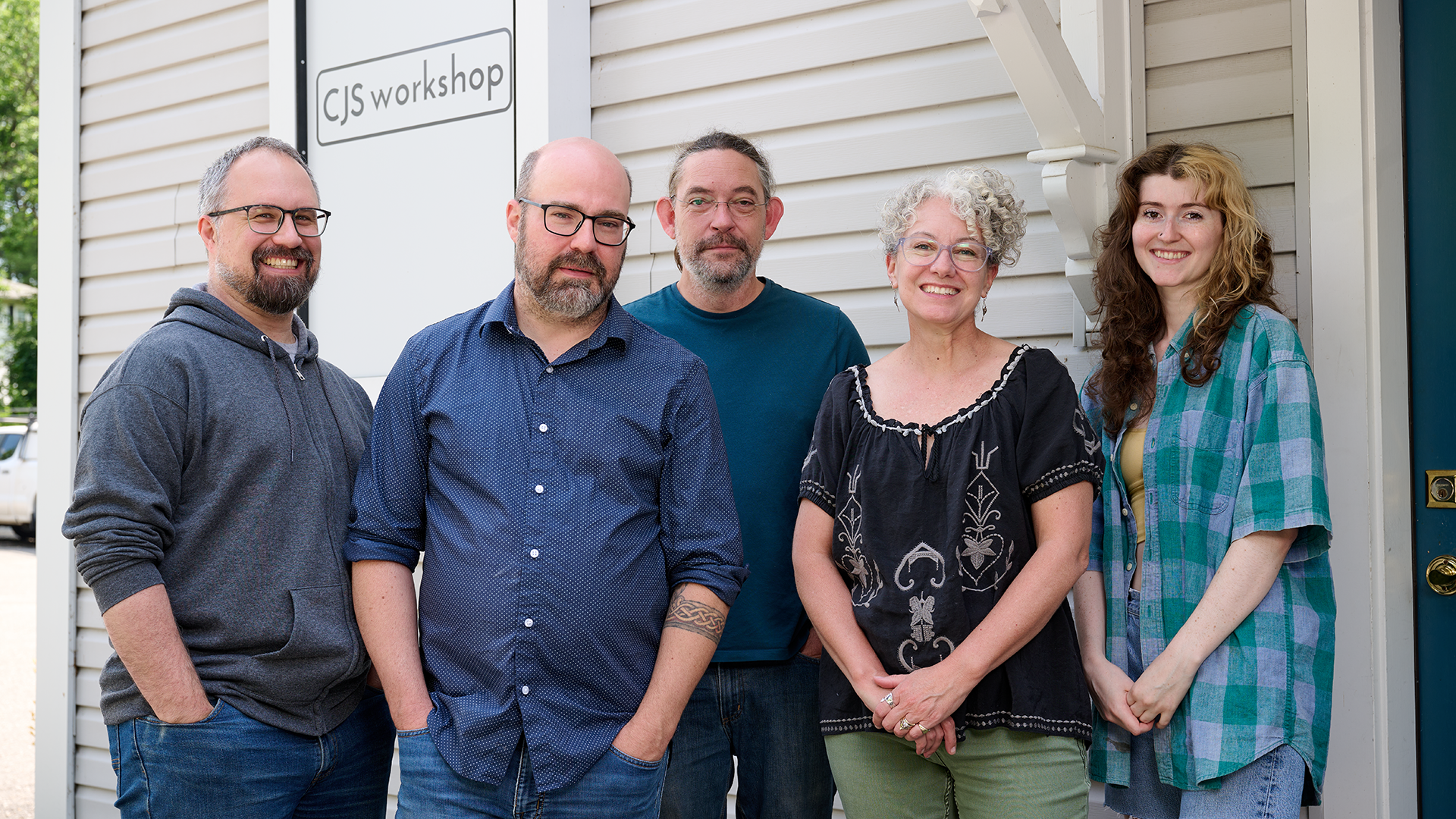
From left: Dana Samborski ’01 (SFA), ’15 MA; Rob Saunders ’96 (SFA); Will Pike ’03 (SFA); Susan Doyle Tolis ’92 (SFA), ’94 MA; and Sierra Adamo ’23 (SFA) outside CJS Workshop in June.
Jim Henson Lesson #3: I believe that we form our own lives, that we create our own reality, and that everything works out for the best.
On a trip to a fiber supplier in Lawrence, Massachusetts, in 2022, Saunders’ world took another turn. “I shared my dream of establishing my own puppetry workshop with the owners,” he says. “To my surprise, they offered me a space in their facility to make that a reality. It was a gift that I couldn’t refuse.”
And so, CJS Workshop was born — a costume design, fabrication, and maintenance studio catering to themed entertainment and commercial advertising. Eventually the studio found its permanent home in Groton, Massachusetts, and operates out of an 8,000-square-foot building near the picturesque River Road Trails, where cyclists pass by daily.
“I live walking distance to the workshop,” Saunders says, waving his arms toward the studio’s windows that boast a New England treelined view. He also mentions he needs to end the interview soon to pick up his three young sons — Christopher, Jacob, and Samuel, who inspired the name CJS — at a public school just minutes away.
Jim Henson Lesson #4: Watch out for each other and love and forgive everybody. It's a good life, enjoy it.
When the talk turns to his vision for CJS, however, Saunders stays planted and engaged, eager to share how he is actively recruiting to expand his team of 16. Right now, he counts four UConn alumni on his team. “I’m always on the lookout to hire people from the program,” he says. “UConn is good about reaching out to me about people they think I might want to work with.”
Saunders is intent on fostering a collaborative, diverse, positive, and respectful culture. He seems like the type of boss you’d want to work for and have a beer with; he speaks with genuine empathy and has kind eyes. “Service to our clients and each other is paramount,” he emphasizes. “We have a responsibility to care for one another.” His company’s four-day workweek is one way he prioritizes a healthy work-life balance.
Remembering his salad days of initial excitement and discovery in New Hampshire, Saunders is also committed to lifting young artists. “I often meet kids at puppet festivals or through my old high school that have unbelievable talent but lack the support to pursue their artistic dreams,” he says. “Parents sometimes struggle to understand a career path in the arts. The key is to showcase the talent and hard work involved, and the fact that you can make a living at it. Of course there are challenges and risks, but that’s true for any profession.”
What about Saunders’ own parents? Did they support his passion? He pauses to find the right words, then shares, “Neither of my parents came from an artistic background — my dad was an electrician, and my mother worked in a nursing home. The concept of puppetry was foreign to them. While they didn’t actively encourage it, they didn’t dismiss it either.”
Right now, he worries about who will take over for his generation of old-school puppeteers. Yes, there is digital puppetry and CGI, but Saunders believes there will always be a need for live performance.
He hopes CJS Workshop acts as a beacon for the next generation of artists. “It costs me nothing to talk to these kids about what it takes to be in this trade. There are the ones who are hungry for it, and you know they’ll do all right. For this profession, you have to fight for it daily. You have to want it daily. You need to be fueled by the hunger for art.”

Great article on a very talented man. I had the pleasure of working with Rob in Los Angeles and almost immediately I knew the production could not have chosen a more driven and talented leader than Rob. It’s so great to read that he is still pushing the art of puppetry and that he’s still fueled by his hunger for art! Bravo!